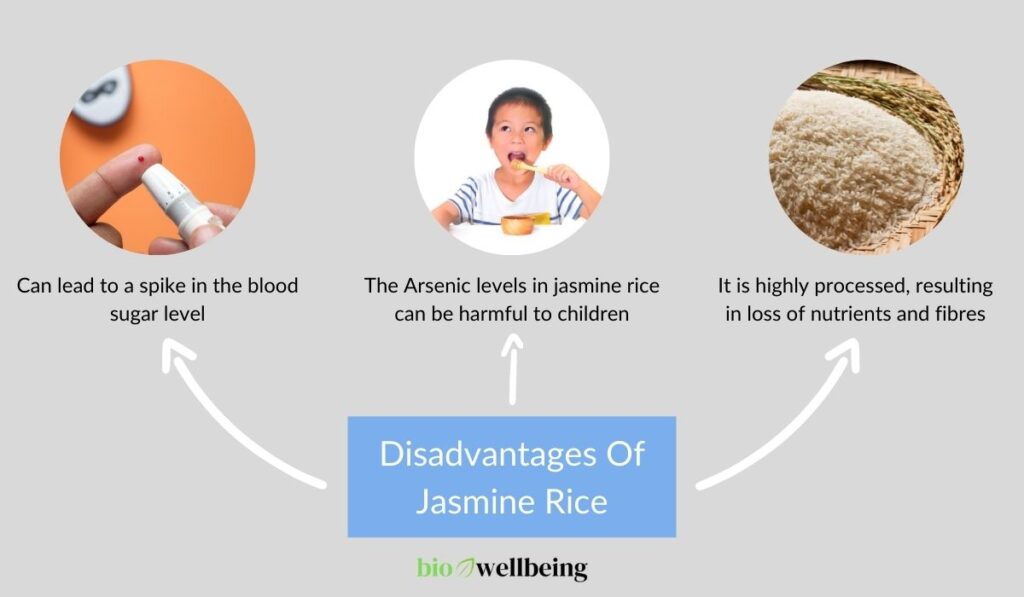Jasmine rice is fragmented rice and belongs to Oryza Sativa. Jasmine rice is a very popular variety of rice. This rice originated from Southeast Asia. Jasmine rice is characterized as soft and moist when cooked. The rice becomes sticky when cooked.
POST CONTENTS
Jasmine Rice For Diabetes
Diabetes is a chronic illness that occurs when our blood sugar rises. When our body does not produce enough insulin, glucose does not reach our cells properly, leading to an increase in blood sugar. People with diabetes, are advised to have a proper diet and perform the proper exercise.
Read More: Diabetes: Type 1 & 2, Gestational, Causes, Treatments, Insulin, Symptoms
Jasmine rice has a comparatively high glycemic index. Also, jasmine rice is rich in carbohydrates and calories. Jasmine rice can cause an immediate spike in the blood sugar level, leading to complications in people with Type 2 diabetes. With increasing blood sugar, the pancreases release more insulin that has less amount of glucagon in the bloodstream.
Glycemic Index Of Jasmine Rice
Glycemic index can be defined as a method of assigning numbers to foods containing carbohydrates based on their relationship with increased blood sugar. Jasmine rice has a glycemic index of around 60-80. According to the glycemic chart, food with a glycemic index of 70 and lower is considered safe for people diabetics. However, lower GI foods ( ≤ 55) are a better option for diabetics.
Looking only at the glycemic index may seem to be wrong, hence let’s have an overview of the glycemic load of jasmine rice. The glycemic load of jasmine rice is around 45.78. The load is high and hence it is advised for the diabetic to consume less amount of jasmine rice.
Well, people with diabetes, should maintain a proper fraction of food. They can consume jasmine rice, but with other vegetables and proteins.
Nutritional Value Of Jasmine Rice
With respect to 1 cup of jasmine rice, the nutritional value of jasmine rice looks somewhat like below:
- Calories – 181
- Proteins – 4g
- Fat – 1g
- Carbs – 38g
- Fiber – 1g
- Calcium – 2% of their daily value
- Iron – 2% of their daily value
In addition to these, jasmine rice contains Thiamine, Niacin and is rich in folic acid.
Is Jasmine Rice Good for Diabetes?
Both the glycemic index and the glycemic load are high for jasmine rice. Also, jasmine rice is rich in carbs. People suffering from diabetes are usually prevented from consuming foods with a higher glycemic index. Hence to answer the question, ‘Is jasmine rice good for diabetes’, it is usually not preferable as it can lead to a spike in the blood sugar level. People with diabetes can always jasmine rice with other fractions of food which can cause a balance for the overall diet.
Advantages Of Jasmine Rice

- Better immune system – Jasmine rice are stuffed with phytonutrients. These helps in protecting our body’s cell and in improving our overall immune system.
- Good source of Iron – Jasmine rice can serve as a provider of iron for our daily intake. Iron helps the cells in our body to produce energy and supplies outer tissues with oxygen.
- Good for Pregnancy – Jasmine rice is a rich source of folic acid. The folic acid promotes healthy pregnancies. The folic acid in jasmine rice helps to reduce birth defects and neural tube defects.
- Digestive health – Brown jasmine rice has a good amount of fibre, and it is less processed. The fibre present helps in bowel movements and thus the digestive health.
- Good source for energy – Jasmine rice has good amount of carbohydrates and calories. Our body generally breaks the starch and energizes our brain, muscles, and tissues.
Disadvantages Of Jasmine Rice

- It can lead to a spike in the blood sugar level and hence not preferable for diabetics.
- The Arsenic levels in jasmine rice can be harmful to children. Hence, the jasmine rice should be washed properly before cooking.
- Although it is highly processed, resulting in loss of nutrients and fibres, brown jasmine rice is healthier than white jasmine rice.
Comparison Between Jasmine And White Rice
Jasmine rice and white rice are bestselling among the varieties. Both jasmine rice and white rice are derived from the same plant, Oryza Sativa. Brown jasmine rice is nutritionally dense. The two varieties of rice look similar. Jasmine rice is four-time longer and much thinner than white rice. While white rice usually clumps together, long-grain jasmine rice is known to produce soft rice. Jasmine rice is usually rich in fragments. White rice is usually bland and sweet, whereas jasmine rice is usually bland. Jasmine rice may contain more calories, but brown rice is healthy in comparison to white rice. Broken jasmine rice provides us with more protein and fibres.
The Bottom Line
Jasmine rice is a long-grain rice that has fragments close to the jasmine flower. There are usually two main types of jasmine rice – white jasmine rice and brown jasmine rice. It is rich in carbs and calories. For people with diabetes, jasmine rice is not preferable because of the high glycemic index. But a diabetic can consume jasmine rice with other vegetables and proteins in a very moderate amount.
Reference:
- https://en.wikipedia.org/wiki/Jasmine_rice
- https://www.healthline.com/nutrition/jasmine-rice-vs-white-rice#nutrition
- https://www.webmd.com/diet/jasmine-rice-good-for-you#1
- https://whatisthebestricecooker.com/is-jasmine-rice-good-for-diabetics/
- https://healthyeating.sfgate.com/health-benefits-stabilized-rice-bran-9601.html

[…] “Jasmine Rice for Diabetes: Is it Safe?” (2022) https://biowellbeing.com/jasmine-rice-for-diabetes/ […]
Very helpful.
[…] people who have diabetes, either Type, can eat a small amount of rice. The remainder of the meal needs to balance out the glycemic […]